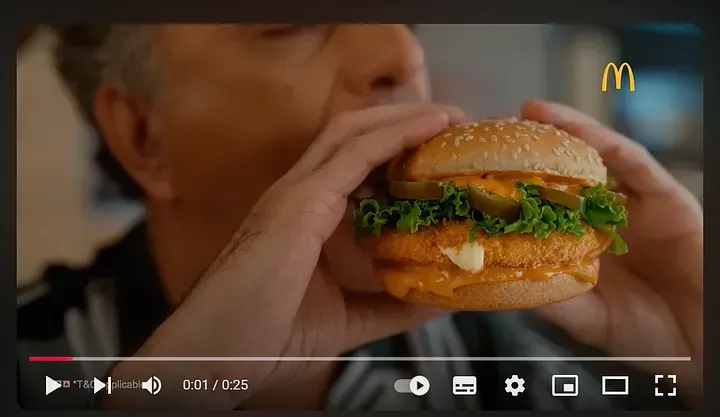A Simple Content System for eCommerce Brand-Building


Our marketing team and I are having a meeting call with the DTC brand team. They asked, “Last week, sales were great, and we got 400+ orders daily, but what happens now? “Sales are dropping, and now we are around 300 per day. But the budget was the same as the previous week. Why is this happening? “ We want to maintain 500+ orders. So what can we do about that?
Those words stayed with me, ringing in my head. They were not the only brand that struggled to scale its e-commerce business. The same problem repeated over and over across early-stage brands.
Brands were coming along to consult or work with me. They believe spending money on awareness campaigns is a waste because we are not seeing any results in short-term revenue growth.
They didn’t believe that creating awareness and building an audience for TOMORROW was the way to grow the brand, which had already reached its first million sales.
They are stuck in the trap of scaling during social momentum and see 3X higher sales with the sale-oriented paid campaigns.
In the long term, brand-building activities are appropriate for some brands. However, many needed some education about how to scale the brand after reaching 1M in sales.
I started discussing this with the brand founders because those people are not 0 to 1; they have already reached 1 and want to be 1 to 10. And by focusing on brand building, we have seen the brand sales growth with the following channels:
Direct visits increased atleast 25%.
Organic Brand Searches increased from 0 to 1000+ searches within 3 months.
Market Place Organic Sales increased by 200%.
Ad cost per acquisition is down by 20% & conversion rate increased by 30%
In this modern era, we can’t increase the organic ranking for general keywords or generate organic traffic via social media.
But through storytelling with ads and influencer collaboration, you can build your brand name as a keyword, as no one can rank for that easily.
In this article, I will explain the things I have learned & implemented to 40+ D2C brands for sustainable & profitable growth.
Understanding Short-term revenue & Its hidden impact.
Many marketers claim that I scaled sales 3X within 3 months. They tell us, “Budget scaling and creative testing will grow the revenue massively.”
But they often miss something crucial. Sudden scaling works in only two possible ways: reaching new customers at a surface level, which happens based on the factors below.
Early-stage customers: These customers are in the current market segment and are willing to try brands even if they are new.
When reaching early-stage customers, you can reach around 25,000 to 50,000 initial customers. Then it will start falling.
Social buying behaviour: People actively seek to buy based on cultural momentum. So, the buying intent is very easy, and some people are interested in buying from a brand.
After trying the same tactics for a couple of years, your sales are not growing, and your growth looks like the one below.
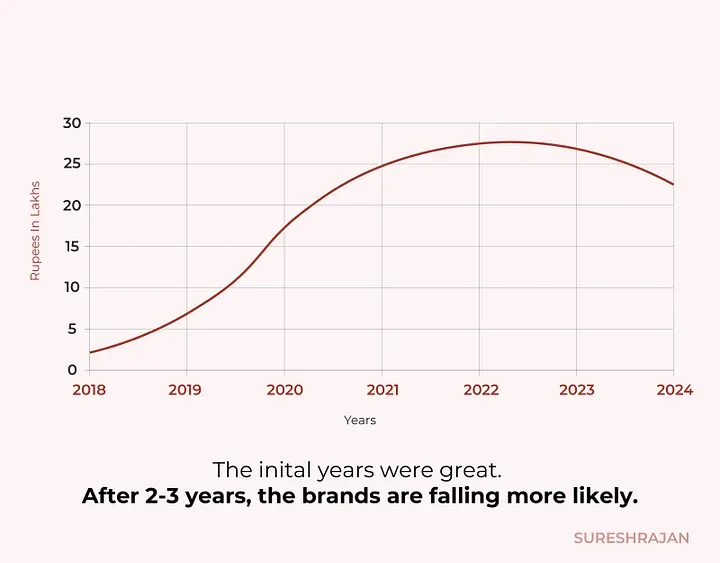
In this stage, founders try to get support from other marketing agencies. They say that we need to balance with brand marketing.
So, founders give it a try and expect revenue or ROAS-focused results.
It doesn’t end there. How you feel also influences your perspective about marketing and how we can grow.
How a few days of no results with brand marketing campaigns can spiral into frustration about brand-building activities and the mindset that we can’t scale and let’s play small without making losses.
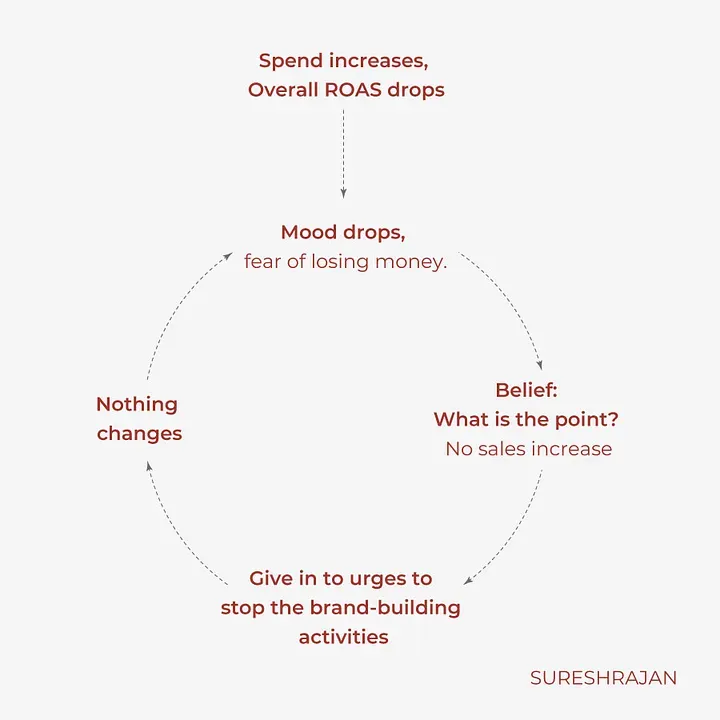
Breaking the cycle is easier if we learn early & act on it.
What to Expect and What Not to Expect When Implementing Brand-Building Activities
The fear of losing money urges us to stop these activities. We want to return to the normal stage, where we see the ROAS as a growth metric. This may look good in the short term, but as you know, it will not help scale the brand in the long term.
Before you learn how to implement, here are the things that will help you set the right mindset. This will make your process smoother and easier to implement.
No short-term revenue goal: Don’t look at the short-term outcome metrics like revenue, ROAS
Traffic Increases, but conversion drops in a shorter time: When you do brand-building activities, the conversion rate initially drops because you may bring more people to the store to create awareness. Since they don’t have buying intent, they will not convert.
Building the audience for tomorrow: Know that you are doing activities to increase your audience size. These prospects will convert when they enter the IN MARKET tomorrow or later when they have the need,
Don’t beg for sales: Don’t run sales with related ad campaigns. Never push them to buy the products right now.
Monitor Audience Metrics: While running campaigns, monitor metrics like clicks, CTR, and Total views, which are how many people viewed the videos, how many people we reached, and how much they spent on the videos and website.
Be consistent for 6 months. Keep doing it for at least 6 months to see some changes. I understand without sales, early-stage D2C brands may not have cash flow. You will learn how much of your budget you should allocate to brand marketing.
4 Steps to Create Content System for E-commerce Brand-Building
1. Create a storyboard: Understand customer psychographic behaviour.
You know what the single worst marketing decision you can make is? Starting to build a brand without understanding customers' stories (Pain, Desire, etc).
Yet, for years, founders and marketers have been using this scenario to start running ads, launching products, creating product pages, and more.
We all told ourselves that “People want a product at a lower price, not their stories that want to listen”.
Then, they wondered why marketing strategies were not generating sales and why they were unaware of the brand after spending a lot of money.
What attracted me to creating customer stories from the start was that People do not make buying decisions logically; most decisions are made emotionally.
The brand stories should be developed until customers can relate them to their lives.
In other words, the best brand-building decision you can make is to have a story that includes real pain and desire for a real group of people, no matter how many times refining this takes.
Here is a quick visual example of what people are looking for & why they remember the brand.
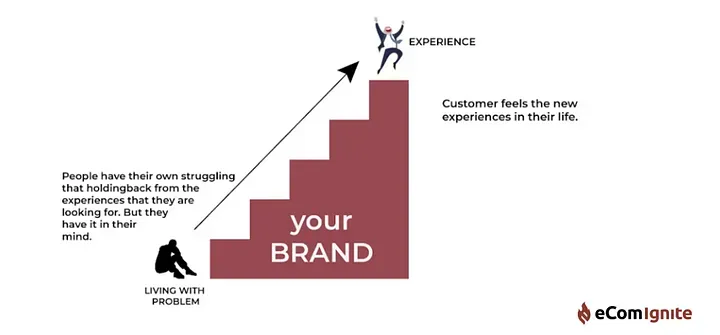
Here is the list of things you understand about the customers to create the stories.
Pains
Desire
Trust
Features
If you ask me how we are going to implement all of the things together? You do not need to implement all factors from your research together. For example, You can see the desire as a prominent communication below “also steal the spotlight wherever you go”. Similarly, you need to include different story angles that need to be implemented.
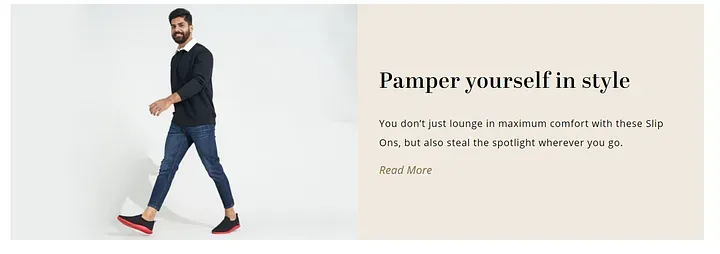
💡 The more people problem you solve, the more revenue & profit you can take. When you solve customers’ problems, people love to buy & recommend it to others.
2. Research Story ideas with personalization.
Once you create the brand storyboard, what kind of pain or problem are they facing, and how do they want their desired life to be? you come to the realization of what kind of stories they love to hear from the brand.
Now it is time to research & come up with ideas across various places like
Competitors social media.
Forums
Your stories clearly state what your brand can solve & how it makes them feel about the product & brand. Here are some of the examples I came across on the internet.
2.5M — How a man wakes up with a smile, kind without feeling lazy

1.5M views — Before & After hair growth comparison

1M — Just Aspiration looks with different postures.

7.2M — It is a kind of satisfaction video & family together. It is an ad.
